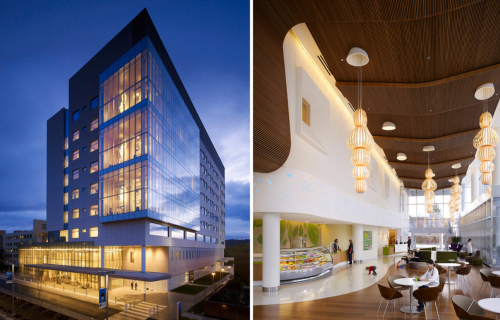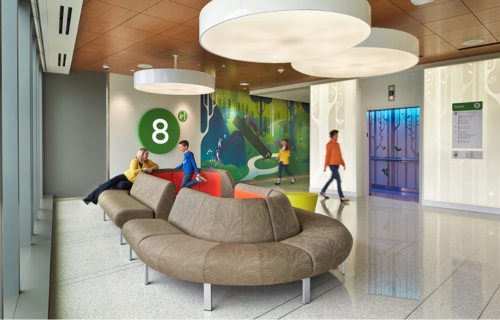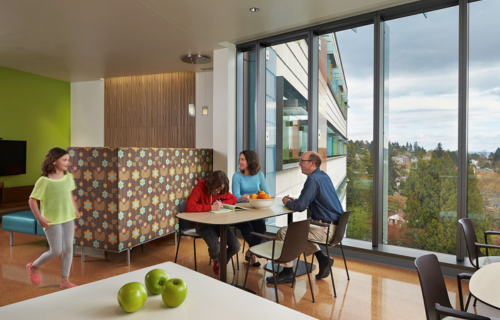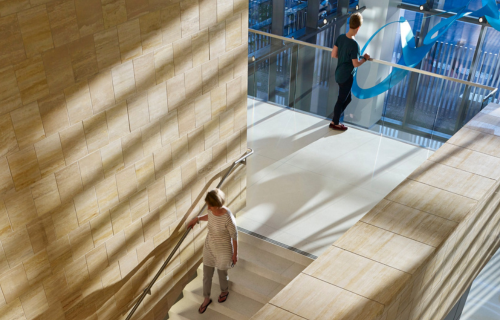The design has the power to profoundly influence the structural and aesthetic aspects of hospital architecture and construction. Every facet, from the choice of sustainable materials to innovative spatial configurations, is meticulously crafted to ensure both functionality and a therapeutic atmosphere. Our curated list presents the foremost 'Hospital Design Trends', providing insights into the dynamic shifts and innovations in the healthcare design sphere.
1-Architecture & Campus Design
Good campus planning and architecture allow the layout of streets, building approaches and building entries to serve as wayfinding devices. Trying to read signs while driving is nerve-wracking. Vehicular access and approach roads should be designed to be intuitive and clear to alleviate stress on the commute. In addition, choices in scale, lighting and materiality for the main entry to the hospital, parking structures, and medical office buildings put patients and their families on the quickest path to the front door. Locating vertical circulation towers and major public spaces near main entries serves as a beacon for those arriving at night, signaling to patients and families where to go with clearly illuminated entrances.

2-Internal Wayfinding
When architecture, medical planning, interior design and environmental graphics harmoniously blend, a first-time visitor can walk through a space without the aid of “you are here” maps. Aligning the patient journey with key architecture and interior elements alleviates the need for excessive signage, which can become distracting. Less signage also means more room for the design that creates joy and delight. For example, bold colors or visually distinct changes at elevator banks pull people toward them. Using the concourse concept or promenade to connect departments together is a way to intuitively organize wayfinding.
3-Welcoming Design Aesthetic
Good hospital design should reflect both the region and the visual and cultural ethos of the institution. Today, many institutions reference elements of hospitality design when discussing their vision for new buildings. This includes covered drop-offs with valet parking, open and transparent lobbies and public spaces, and warm, natural materials that evoke a sense of comfort. Concierge and check-in services are becoming more common. Art and sound play a key role in creating a calming and welcoming aesthetic and providing positive distractions upon arrival.

4-Pleasant Clinical Environment
Patients and staff benefit from a well-designed space. While it is tempting to focus only on lobbies and waiting areas, clinical areas need just as much attention. Imaging suites, procedure rooms where patients are conscious, and blood-draw stations benefit from natural daylight and positive distractions in art, material palette and views. These areas are critical in creating a calming and healing environment.
5-A Better Waiting Area
The same holds true for check-in desks and waiting areas – use the spaces and their visual identities to intuitively help patients navigate. The waiting room is one of the most stressful parts of a visit so make it an amazing place to be: provide expansive views, windows for daylight, art and beautiful, comfortable furniture. Locating waiting areas along the perimeter is an effective way to promote wayfinding and mitigate patient and family stress.

6-Drop-Off and Parking
There is no better way to feel that you are being taken care of – pampered even – than by eliminating all worry of arrival, drop-off and parking. Free valet services reduce the stress of finding a space, paying and returning to your car. An expanded vehicular drop-off and pick-up area accommodate these services. It is also adaptable for ride-share and a potential autonomous car revolution. With more patients and visitors utilizing alternative arrival methods, this drop-off sequence will become more important than ever before as parking garages shrink or are converted to other hospital functions.
7-Onstage / Offstage Environments (The Disney Effect)
Today, many healthcare institutions take cues from Disney’s onstage/offstage concept, where impeccable service appears to happen seamlessly. When designing a new hospital, it isn’t just about separating experience areas from service areas but designing a circulation and planning diagram that allows the separation of goods and services from patients and their families, both vertically and horizontally. There are varying degrees of this separation and many influential criteria. For example, adding service and patient transport elevators centered in the patient wing instead of at the end of the units decreases the amount of crossover between patients and services.

8-Healthy Building = Healthy Occupants
Healing happens inside hospitals and the building itself should participate in that healing process. Designing with Red List-free materials, providing clean and filtered air, and offering access to outside experiences with operable windows or terraces in places where immune systems are not compromised are all strategies for healthier buildings. Looking beyond patients to a healthier planet, excess heat, rain and wind should be captured and stored for use. Since hospitals are mission critical facilities and need to remain open and accessible after events like wildfires, tornados and earthquakes the perfect hospital is a standalone, net zero, resilient structure.
9-Personalization and Choice
Personalization goes a long way in creating a comforting experience. It also helps patients and their families have a better visit – potentially leading to better outcomes. Just think of all the different ways for patients to customize their experience: change room color or lighting; pick from a group, semi-private or private room for infusion or dialysis treatment; customize overhead music or artwork; select from city or river views. When patients are offered choice it provides a feeling of control over their visit and their care.
10-Dignified Discharge
Finally, consider how to give a dignified exit for patients who are leaving the hospital, but still require assistance. Provide a comfortable and private discharge route that does not go through the main hospital doors for those using crutches or a wheelchair for the first time or recovering from a day procedure. This not only provides the departing patient with a more dignified departure but can calm the nerves of new patients entering the hospital.
As we navigate these pivotal design principles, it becomes evident that the arena of hospital design is in constant evolution. These elements, while universal, take on a unique significance within different cultural and regional contexts. Saudi Arabia, with its strategic vision and substantial investments in healthcare, stands at the cusp of a transformative era in hospital design and construction. For those looking to delve deeper and align with the future of healthcare infrastructure, our "Saudi Hospital Design & Build Expo" serves as the definitive gateway to tap into the Kingdom's boundless opportunities.
Source: Architizer
Subscribe to Saudi Hospital Design & Build Expo newsletters to get informed on all events news and updates.